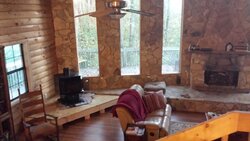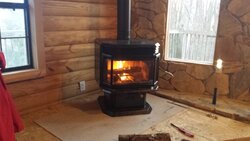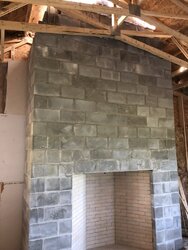Simonkenton
Minister of Fire
I am an expert, because I built the fireplace pictured at left. This is an all masonry fireplace on the Rumford model and is the best heating fireplace I have ever used.
If you want a fireplace you must do one like mine that is entirely within the house, because the back wall of the fireplace puts off a lot of heat. And, going the other way, on an exterior fireplace, on a cold day when you are not running the fireplace, that 20 degree temp is running right through the masonry and into your living room.
Also you have to have an exterior air intake of at least 90 square inches.
This bad boy is in a room that is 16 x 20 with 8 foot ceilings and will heat it easily. Burn for 5 hours, let the coals go out, shut damper, and it will heat 1100 sq ft for 24 hours on a 32 degree night. Pretty good for a fireplace.
But I have had 7 wood stoves, over the years, and now have a shiny new Jotul Oslo. I built an addition onto the house two years ago to make room for the Oslo, so the wood stove is in the other living room, I have 2 living rooms. The wood stove makes as much heat as my badass fireplace, and uses 1/5 as much wood.
Still, you can't beat the ambiance of a good ol' American stone fireplace.
If you want a fireplace you must do one like mine that is entirely within the house, because the back wall of the fireplace puts off a lot of heat. And, going the other way, on an exterior fireplace, on a cold day when you are not running the fireplace, that 20 degree temp is running right through the masonry and into your living room.
Also you have to have an exterior air intake of at least 90 square inches.
This bad boy is in a room that is 16 x 20 with 8 foot ceilings and will heat it easily. Burn for 5 hours, let the coals go out, shut damper, and it will heat 1100 sq ft for 24 hours on a 32 degree night. Pretty good for a fireplace.
But I have had 7 wood stoves, over the years, and now have a shiny new Jotul Oslo. I built an addition onto the house two years ago to make room for the Oslo, so the wood stove is in the other living room, I have 2 living rooms. The wood stove makes as much heat as my badass fireplace, and uses 1/5 as much wood.
Still, you can't beat the ambiance of a good ol' American stone fireplace.
Last edited:




